Appropriate bicycles for ‘slow’ utility cycling:
Imagine living in a world in which when you needed to buy a car for your everyday needs: shopping, getting around in all weathers etc and being presented with a choice of Formula 1 racing cars and racing saloons.
- So it is with cycling in New Zealand,-with bicycles designed for off-road recreational riding being presented as the only option for use on flat city roads while the market is deprived of the alternatives which will inevitably prove to be more appropriate for urban environments .
There is a disappointingly restrictive lack of variety in the choice of appropriate cycling technologies being offered by all but a small handful of brave cycle retailers in New Zealand.
i.e. mountain bikes prevail in Christchurch city which is (for the most part) dead flat.
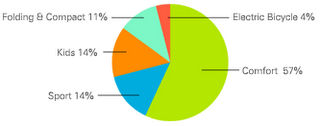
This graph is from Japan's biggest bicycle manufacturer 'Bridgestone' which has 11% of the market in Japan.
I'd guess that a similar graph for bicycle sales in New Zealand would look more like:
sports cycles 80% , kids, 19.99 %,
'comfort cycles' 0% , folding & compact and electric bicycles 0.01 %
Some examples of bikes that may prove to be more appropriate for use by urban 'utility' cyclists.
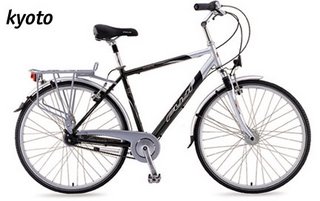
'Kyoto' by Fuji Bikes.
( ironically now manufactured in the U.S.A. and not available in Kyoto ,-although similar bikes are.
I personally used a similar bike in Kyoto for 4 years with 7-speed internal hub gearing , grip shift , internal hub dynamo for halogen lights with baskets on both front and back, complete with bells and umbrella holder.
I would never go back to a mountain bike.

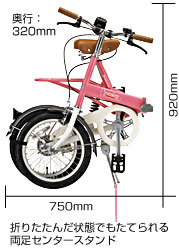
'Sneaker' Folding bike by Bridgestone (with 3 speed internal gearing) .
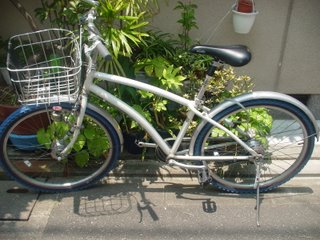
Basket on the front , bell from a dynamo , internal hub dynamo lights , 7-speed internal hub with grip shift , mud-guard, chain-guard, kick-stand, mountain bike tyres. ( you can click on these pictures to enlarge them ).
There seems to be a cultural reluctance among the bicycle retail industry in New Zealand to provide consumers with the choice to even experiment with the kinds of bicycles that would take cycling from being just something kids or young athletic types do, to becoming an intrinsic part of our everyday urban commuter transport infrastructure.
If people working in the cycle retail industry here are aware of the developments that are happening with commuter cycling in other countries, it isn’t being reflected in what they are presenting to the market.
Leaving it to ‘the market’ to arrive at the optimum outcome is obviously not working in the interests of promoting utility cycling in New Zealand.
A large percentage of the people who could, would and should be cycling now are probably not cycling for the simple reason that they can’t imagine being comfortable in the stooped low-down posture that must be adopted when riding mountain or road-racing bikes.
Most 'would-be' utility cyclists are probably put off by the fear that they'd have to ride as fast as they can go to have the right to a place in on-road cycle lanes.
Retailers are only catering for what they perceive is left of their market: recreational and ‘leisure’ cyclists.
There are scarce few alternatives provided for those who want a more pragmatic and comfortable cycling experience.
The cycle retail industry in New Zealand is excluding the sector which makes up the largest part ( 57% ! ) of the bicycle market in Japan.
An education campaign would be useful in helping the potential cycling public to become aware of the range of choices that exist to create the demand and facilitate the change from carbon burners to bicycles.
The Christchurch City Council could have a facilitative role in promoting a much wider range of bicycles to appeal to the wider public by hosting a Commuter Cycling Trade Fair to which foreign bicycle manufacturers could be invited from countries such as Japan, the Netherlands, Denmark, Germany and China to make contact with local retailers.
Funding could potentially come from participating commercial interests.
Even more amazing than how good ideas spread quickly is how they don't.
Urban utility bicycles from Sweden:
Koga Bicycles from the Netherlands
Gazelle Bicycles from the Netherlands
Pashley Bicycles from England
Nihola from Denmark
Urban utility cycling will never take off in New Zealand until cycle retailers in New Zealand start making bikes like these available to enable a much wider range of people to make the change.
A permanent or mobile display of various types of commuter cycles could be maintained by Local Governments to remind people of the alternative technologies that may help them to make the switch from driving to cycling.
---------------------------------------------------------------------------------------------------------
Some examples of alternative technologies not (commonly) available in New Zealand but which may be more appropriate for utility cycling in urban areas:
Traditional upright posture.
----------------------------------------------------------------------------
Internal hub gearing systems:
Internal 3,4,7 or 8 speed gearing systems manufactured by companies such as Shimano are popular in Japan as opposed to the dérailleur systems which are the only choice being offered by 99.9% of cycle retailers in New Zealand.
Low maintenance Internal hub gearing systems are more appropriate for riding in urban environments especially because gears can be changed very quickly to respond to the stop/go situations that cyclists often find themselves in on city streets.
Gears can also be changed while stationary whereas the dérailleur system used on mountain bikes necessitates that riders change gear while moving before entering a situation, -which can be a bit tricky when riding in the midst of motor - vehicles.
Losing your chain when trying to get out of the way of a car could be fatal.
--------------------------------------------------------------------------------------------------------------
Check out some of these web-sites for a look at some examples.
http://www.koga.com/uk/segment.asp?collection=7&segment=56
http://sheldonbrown.com/internal-gears.html
An excellent web-log on Internal Hub versus derailleur gearing systems in Portland, Oregon .
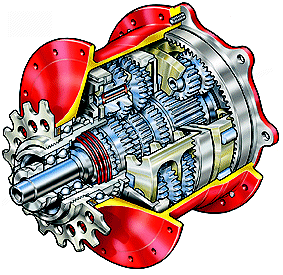
--------------------------------------------------
Internal hub powered lighting systems:


Internal hub dynamos are very commonly fitted into the front wheel on bicycles in Japan to provide power for lights.
They are silent, have no drag and are a world away from the noisy old 'burn your-front tyre and sap your energy' dynamos used in the old days.
Using an internal hub dynamo eliminates the need to use wasteful disposable battery powered lights which often run out in the middle of journeys.
Internal hub dynamo systems with LED and halogen lighting.
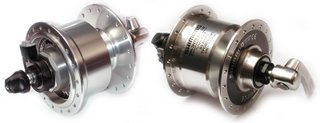
Why aren't these fantastic lighting systems being made available by cycle retailers in New Zealand ?
- Because ‘the market’ doesn't want them? Yeah, -right!
Carrying devices: Baskets attached to the front and back of bicycles are a major pragmatic advantage for commuter cyclists by enabling the carriage of shopping, books etc.
Mudguards and chain-guards: Quaint technologies from a bygone era but essential for riding in bad weather or in work clothes.
----------------------------------------------------------------

eXe folding bike with 20 inch wheels and 3 speed internal hub gears.
Folding bicycles:
These have become well established in Japan and are very useful for those who want to maximise their freedom in central urban areas after having reached them by either car (as part of a car-pooling cooperative) or on public transport such as bus or train.
http://www.bromptonbicycle.co.uk/
http://store.nycewheels.com/folding-bike.html
--------------------------------------------------------------------------------------------
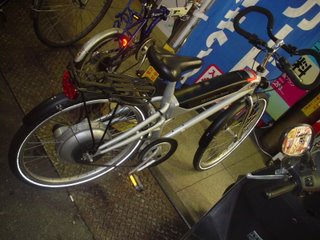
A Mercedes Benz Electric Bicycle Electric Power Assisted Bicycle: e.g.
Panasonic Bicycles
The Bakfiets Cargobike
Living with the Dutch kid and cargo hauling workhorse in Portland, OREGON U.S.A
- So it is with cycling in New Zealand,-with bicycles designed for off-road recreational riding being presented as the only option for use on flat city roads while the market is deprived of the alternatives which will inevitably prove to be more appropriate for urban environments .
There is a disappointingly restrictive lack of variety in the choice of appropriate cycling technologies being offered by all but a small handful of brave cycle retailers in New Zealand.
i.e. mountain bikes prevail in Christchurch city which is (for the most part) dead flat.

This graph is from Japan's biggest bicycle manufacturer 'Bridgestone' which has 11% of the market in Japan.
I'd guess that a similar graph for bicycle sales in New Zealand would look more like:
sports cycles 80% , kids, 19.99 %,
'comfort cycles' 0% , folding & compact and electric bicycles 0.01 %
Some examples of bikes that may prove to be more appropriate for use by urban 'utility' cyclists.

'Kyoto' by Fuji Bikes.
( ironically now manufactured in the U.S.A. and not available in Kyoto ,-although similar bikes are.
I personally used a similar bike in Kyoto for 4 years with 7-speed internal hub gearing , grip shift , internal hub dynamo for halogen lights with baskets on both front and back, complete with bells and umbrella holder.
I would never go back to a mountain bike.


'Sneaker' Folding bike by Bridgestone (with 3 speed internal gearing) .

Basket on the front , bell from a dynamo , internal hub dynamo lights , 7-speed internal hub with grip shift , mud-guard, chain-guard, kick-stand, mountain bike tyres. ( you can click on these pictures to enlarge them ).
There seems to be a cultural reluctance among the bicycle retail industry in New Zealand to provide consumers with the choice to even experiment with the kinds of bicycles that would take cycling from being just something kids or young athletic types do, to becoming an intrinsic part of our everyday urban commuter transport infrastructure.
If people working in the cycle retail industry here are aware of the developments that are happening with commuter cycling in other countries, it isn’t being reflected in what they are presenting to the market.
Leaving it to ‘the market’ to arrive at the optimum outcome is obviously not working in the interests of promoting utility cycling in New Zealand.
A large percentage of the people who could, would and should be cycling now are probably not cycling for the simple reason that they can’t imagine being comfortable in the stooped low-down posture that must be adopted when riding mountain or road-racing bikes.
Most 'would-be' utility cyclists are probably put off by the fear that they'd have to ride as fast as they can go to have the right to a place in on-road cycle lanes.
Retailers are only catering for what they perceive is left of their market: recreational and ‘leisure’ cyclists.
There are scarce few alternatives provided for those who want a more pragmatic and comfortable cycling experience.
The cycle retail industry in New Zealand is excluding the sector which makes up the largest part ( 57% ! ) of the bicycle market in Japan.
An education campaign would be useful in helping the potential cycling public to become aware of the range of choices that exist to create the demand and facilitate the change from carbon burners to bicycles.
The Christchurch City Council could have a facilitative role in promoting a much wider range of bicycles to appeal to the wider public by hosting a Commuter Cycling Trade Fair to which foreign bicycle manufacturers could be invited from countries such as Japan, the Netherlands, Denmark, Germany and China to make contact with local retailers.
Funding could potentially come from participating commercial interests.
Even more amazing than how good ideas spread quickly is how they don't.
Urban utility bicycles from Sweden:
Koga Bicycles from the Netherlands
Gazelle Bicycles from the Netherlands
Pashley Bicycles from England
Nihola from Denmark
Urban utility cycling will never take off in New Zealand until cycle retailers in New Zealand start making bikes like these available to enable a much wider range of people to make the change.
A permanent or mobile display of various types of commuter cycles could be maintained by Local Governments to remind people of the alternative technologies that may help them to make the switch from driving to cycling.
---------------------------------------------------------------------------------------------------------
Some examples of alternative technologies not (commonly) available in New Zealand but which may be more appropriate for utility cycling in urban areas:
Traditional upright posture.
----------------------------------------------------------------------------
Internal hub gearing systems:
Internal 3,4,7 or 8 speed gearing systems manufactured by companies such as Shimano are popular in Japan as opposed to the dérailleur systems which are the only choice being offered by 99.9% of cycle retailers in New Zealand.
Low maintenance Internal hub gearing systems are more appropriate for riding in urban environments especially because gears can be changed very quickly to respond to the stop/go situations that cyclists often find themselves in on city streets.
Gears can also be changed while stationary whereas the dérailleur system used on mountain bikes necessitates that riders change gear while moving before entering a situation, -which can be a bit tricky when riding in the midst of motor - vehicles.
Losing your chain when trying to get out of the way of a car could be fatal.
--------------------------------------------------------------------------------------------------------------
Check out some of these web-sites for a look at some examples.
http://www.koga.com/uk/segment.asp?collection=7&segment=56
http://sheldonbrown.com/internal-gears.html
An excellent web-log on Internal Hub versus derailleur gearing systems in Portland, Oregon .

--------------------------------------------------
Internal hub powered lighting systems:


Internal hub dynamos are very commonly fitted into the front wheel on bicycles in Japan to provide power for lights.
They are silent, have no drag and are a world away from the noisy old 'burn your-front tyre and sap your energy' dynamos used in the old days.
Using an internal hub dynamo eliminates the need to use wasteful disposable battery powered lights which often run out in the middle of journeys.
Internal hub dynamo systems with LED and halogen lighting.

Why aren't these fantastic lighting systems being made available by cycle retailers in New Zealand ?
- Because ‘the market’ doesn't want them? Yeah, -right!
Carrying devices: Baskets attached to the front and back of bicycles are a major pragmatic advantage for commuter cyclists by enabling the carriage of shopping, books etc.
Mudguards and chain-guards: Quaint technologies from a bygone era but essential for riding in bad weather or in work clothes.
----------------------------------------------------------------

eXe folding bike with 20 inch wheels and 3 speed internal hub gears.
Folding bicycles:
These have become well established in Japan and are very useful for those who want to maximise their freedom in central urban areas after having reached them by either car (as part of a car-pooling cooperative) or on public transport such as bus or train.
http://www.bromptonbicycle.co.uk/
http://store.nycewheels.com/folding-bike.html
--------------------------------------------------------------------------------------------

A Mercedes Benz Electric Bicycle Electric Power Assisted Bicycle: e.g.
Panasonic Bicycles
The Bakfiets Cargobike
Living with the Dutch kid and cargo hauling workhorse in Portland, OREGON U.S.A
Labels: Appropriate bicycles

2 Comments:
Nice post. I live in Japan, formerly lived in the US. I stopped driving cars when I moved here and though I live in a rural area (rural in Japanese terms anyway) I bicycle everywhere using a fairly typical bike as you describe here, the only difference perhaps being my 6 speeds are external gears.
The only complaint I have with these bikes is that they are unnecessarily heavy with all steel construction, heavy steel kickstands and racks and so on.
This is obviously a cost issue, but a lighter bike would make my 15 km rides into town a bit easier. Aluminum handlebars, crank, seat post, rack and kickstand would help and mud guards can be made of plastic.
The other complaint I have with Japanese bikes is the valves used for tire inflation, which I am sure you are familiar with having lived here yourself. They make maintaining proper inflation a real chore, and under-inflated tires add a lot of resistance.
That said, I agree that they are much better suited to urban riding than are racing style or mountain bikes.
Electric Bicycles and Electric Scooters
Elmo The Electric Bike and Electric Scooter Guy
This is an excellent blog for electric bicycles. There are not too many around like this. Thanks for making this such an interesting subject. Oh, by the way, Wired Magazine has a great article on hybrid cars this month. (Jan 2008 issue).
God Bless,
Elmo
Post a Comment
<< Home